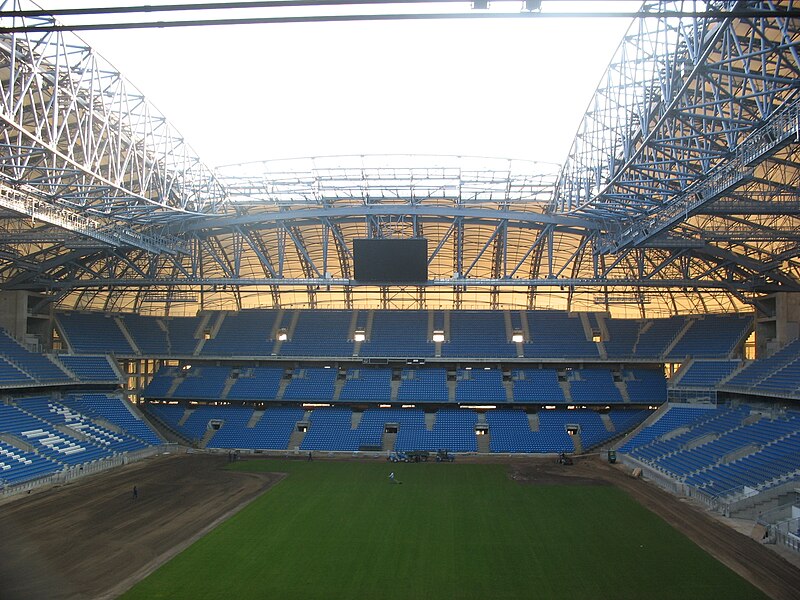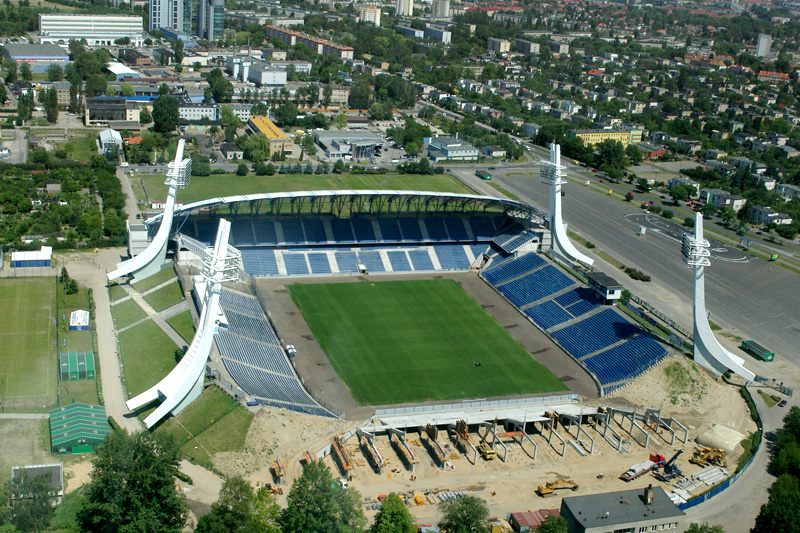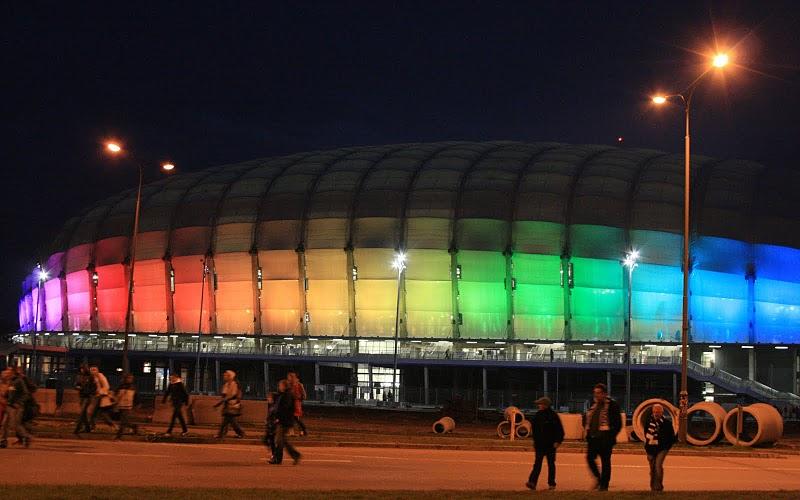Extra-Velganzer,
Jak Sie Masz??..lets continue our travel in Poland, after visiting the gorgeous
National Stadium and PGE Arena Gdansk. Now lets continue our trip in Poland,
looking for another excitement and experience before the kick off of EURO 2012
in Poland and Ukraine. We are still in Poland but we will leaving Warsaw or
Gdanks. We are going to visit Poznan with her A-Magnificient-Zing stadium they
have.
Poznan roughly translates as "one
who is recognised" and if the seemingly endless trade fairs in the city
are anything to go by it certainly is. The fairs provide a huge source of civic
pride (and money) and though of no real interest to the average visitor, the
city – Poland's fifth largest and once a royal seat – has more than enough to
offer elsewhere.
Poznan started life as a ninth-century
wooden fort on a Warta river island before a growing population forced its migration
to the mainland. Under Prussian/German rule from 1793, it returned to Poland in
1919 and the city sparked an intense regional uprising, a spirit revived as the
city also witnessed the first mass protest in the Soviet bloc. With so much
unrest Poznan has over the years undergone all manner of refits, from aesthetic
facelifts to complete rebuilds; not unattractive scars of its history.
After appointed as one of the host of
Euro 2012, Poznan prepared their town to welcome this great event. Not only
prepared the town but also best service for the next star of football players in
Europe with special stadium.
Stadion Miejski or famous with stadion
Lecha broke to the ground in 1968. The year of the story begun. Need 12 years to
build this stadion, such a long story to build a great monument. Compared with
others 2 stadion we already visit before, this stadion need a less construction
cost. Its only obut 180 million euros to rebuild this stadion after it broke to
the ground. The “Ted Mosby” of this stadion is Modern Construction Design Sp. z
o.o. since build in 1968, the stadion renovated for the first time in
2003-2010. Like most stadiums in those times it was built on artificial hills
on which concrete benches and crown of the stadium was later formed. The
construction consisted of three stands (in a characteristic U-shaped style),
while place dedicated for fourth stand was left free. Swimming pool and gyms
were supposed to be build there, but this plan was never realized. It took
almost 12 years to complete the whole structure. The first match on the new
stadium Lech Poznan played on August 23, 1980 with audience of 18,000 people.
The match between “Kolejorz” and Motor Lublin ended in a 1-1 draw. The first
goal scorer for the home team at the new stadium was Mark Skurczyński.
The Municipal Stadium in Poznań is the
first facility for UEFA EURO 2012™ to be completed. Three European Championship
matches will be hosted here in June 2012. Those matches to be played there are Croatia
v. Ireland on 10 June, Croatia v. Italy on 14 June, and Ireland v. Italy on 18
June. (The other three matches in that group will take place at PGE Arena,
Gdańsk.). According to
the reconstruction project, the stadium is completely covered with a roof. The
roof consists of three sections, which can move on the principle of accordion.
This part of the project is believed to be the most expensive and most
difficult in the modernization. The frame of the entire roof structure is made
of steel (about 7,000 tons).
On zero level of the stadium there are
a football pitch, rooms for the players of two teams, locker rooms for athletes
and coaches, as well as showers, saunas, massage rooms. On the same floor there
are arena’s technical support services. The third level is organizational. It
houses rooms for the press and the stadium’s employees, offices and warehouses.
There are two conference halls for 25 and 50 persons, a photo studio. Two
levels are designed for VIP persons: a hotel, two restaurants, two medical
centers and other facilities.
The modernization of the existing
stadium on Bułgarska Street began in January 2009. In well under two years the
stadium has undergone a complete transformation. Now the facility at Bułgarska
Street is modern, multifunctional and safe. Matches during the UEFA EURO 2012™
will be watched by over 43 thousand people, 480 people can be accommodated at
45 sky boxes, 1,100 seats are provided for the business sector, media zone
operates separately. Additionally, 222 seats at the stadium are intended for
the disabled fans: 142 seats or wheelchair users and their companions; 40 - for
people with partial or complete loss of hearing, 40 - for people with partial
or complete loss of vision. For the latter special sportcasters will provide an
individual match reportThe grandstands are completely covered with a membrane
of natural silk. The City of Poznań has invested 713 million PLN in the
modernization of the facility.
Officially opened on 20th
September 2010, the first real test of the facility was a Sting concert. The
artist performed at the stadium during the 2010 edition of the festival:
"Poznań for the Earth" - accompanied by the Royal Philharmonic
Concert Orchestra and conducted by Steven Mercurio. Ten days later the first
football match was held-the match between Lech Poznań and FC Salzburg in the
group stage of the UEFA Europa league. It was attended by 42,000 fans!.
Poznań stadium can boast the two
biggest broadcast screens in Poland, each consisting of 120 smaller LED screens
with an area of 116 m². Previously, the record had belonged to the Warsaw
Riviera and the Katowice Spodek. A lighting rig of lightning power, reaching
2000 lux, can meet the requirements of state-of-the-art HD transmission.
Stadium operates 2 restaurants, bar,
cafeteria and 27 catering stalls with 221 stands for sale. The arena’s parking
space is capable of servicing over 2,000 cars.
How To Get To Municipal/Miejski/Lecha
Stadium In Poznan.
Poznań-Ławica airport is 7km west of the city and has
daily flights to Warsaw as well as regular links to Copenhagen, Dublin,
Stockholm, Barcelona, Germany and England. in the vicinity of the route leading
directly to the major city points and next to the road out of Poznań to Berlin
and Warsaw. It is possible to get to the city centre from the airport using
line 59 or express line L, that is going directly to Railway Station. In line L
the ticket price doubles and one can take one piece of luggage free of charge.Poznań
Główny railway station in the heart of the city offers the best domestic
service with about 20 daily services to Warsaw (3-4 hours). Frequent trains run
to Wroclaw (2.5 hours), Gdansk (4 hours) and Kyiv (18 hours) and there are also
direct services to Berlin, Cologne and Moscow.
All trains coming to Poznań stop at Poznań Main Railway
Station (Poznań Główny). The Railway Station is composed of two buildings: the
Main Hall (Hala Główna) and the West Railway Station (Dworzec Zachodni)
connected by a subway. The Railway Station is located in the city centre, just next to the Poznań
International Fair venue (Międzynarodowe Targi Poznańskie). In the Main Hall
there are kiosks, shops, fast food restaurants, ATM and Glob - Tour tourist
information.
Passengers can get to the city by tram or bus - the
nearest tram stop is next to the West Railway Station. Trams no. 5, 8, 14 and
18 leave the stop. In the vicinity of the Main Hall exit there is a municipal
bus stop for lines 51, 68 and 76. At night, also night buses approach the stop.
To get to the tram stop, passengers should use stairs or a lift leading to the Railway
Bridge (Most Dworcowy). There, passengers can use trams no. 6, 10, 11 and 12.
TAXI ranks are located next to the Main Hall and the West Railway Station exit.
It is advisable, however, to call RADIO TAXI in a point located in the Main
Hall. Automatic train timetable information system (phone no.): 863 38 14, 863
38 15. Central domestic and interantional train information (phone no.): 94 36.
PKS Station (Bus Transport Company) is located in ul.
Towarowa 17/19. It provides both domestic and international transport services.
Apart from ticket offices, kiosks, bar and PKS information point also travel
agencies selling tickets for international routes are located in the bus
station hall. Next to the station there are fast food restaurants, ATM, a bookshop and a cake
shop. In front of the station there is a tram stop for lines no. 6, 10, 11 and 12. Information (phone no.): 664 25 25.



 11:02 PM
11:02 PM
 Unknown
Unknown






 Posted in:
Posted in: 


0 comments:
Post a Comment